Most often a printed document of one or more pages, varying in size and composition. It indicated the standard terms and securities, with blanks provided for conditions unique to a particular policy. Other information would include the name of the vessel insured and the master, a description of the cargo (if insured), the stated value of the insured, the term of the policy, the policy number, the premium, etc.
Marine insurance in colonial America was underwritten primarily by wealthy citizens who pledged to pay a portion of the vessel’s or cargo’s value if it was lost. The owner of a vessel contracted to compensate the underwriters at a specified rate for this protection. This contract was the Marine Insurance Policy. The first United States incorporated company for marine insurance was chartered in 1794, and several others were in business by the end of the century. During the early 1800s these companies suffered from European abuses of our neutral shipping and their losses were frequently severe. However, the business of marine insurance continued to grow and was firmly established by the mid-nineteenth century.
Marine Insurance Policies are often found in maritime collections. As research sources, these documents can provide information about the current values of ships and cargoes, as well as how various forces affected the safety of American shipping.
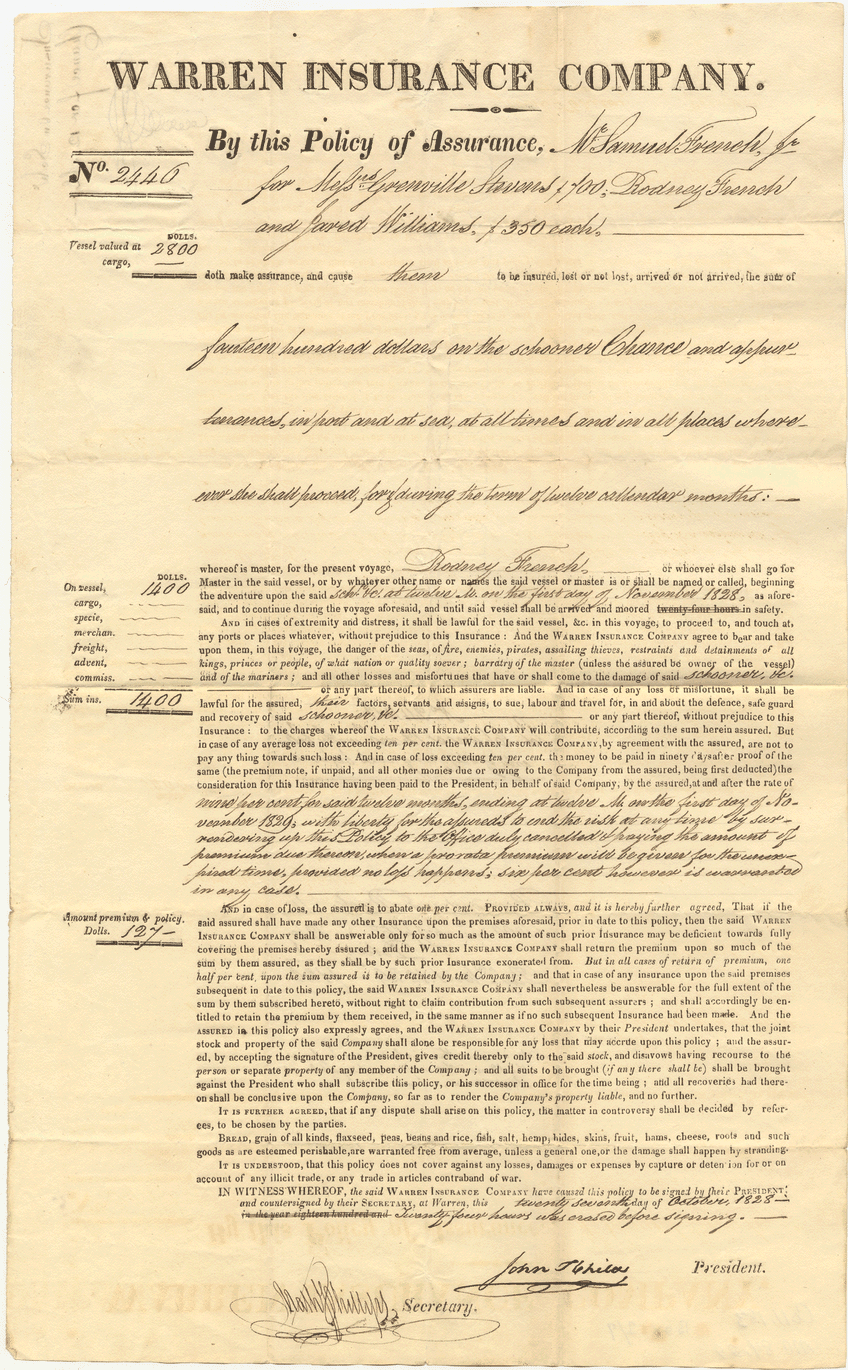
Policy No. 2446 issued by the Warren Insurance Company, of Warren, Rhode Island, for $1,400 on the schooner Chance at a rate of 9% for twelve months, 27 October 1828, is typical of the kind often found in maritime collections of this period.
Documents Relative to Maritime Insurance Claims
Since the owners of the vessel and cargo did not usually escort their interests to their destination, the responsibility to initiate the claims process for loss or damage fell to the shipmaster. When these losses – termed “Averages” – occurred, the first action taken by the master upon arrival in port was to file a Note of Protest. This document was made before a notary public, consul, or other qualified official, by the master within twenty-four hours of the vessel’s arrival. It is a short document, providing the briefest account of the damage suffered. The primary reason for making a Note of Protest was to establish the right to extend the protest in the future should it become necessary.
This extension of the protest, commonly referred to as a “Protest,” was usually a more lengthy and detailed document, describing all the circumstances surrounding the average; the date, the time, the setting and striking of all sails, a characterization of the weather responsible for the damage, what was damaged, what was sacrificed for the mutual good, etc. It was intended to be a clear and accurate statement of the events of the voyage, and was executed before a qualified public official by the master accompanied by one or two other crew members who could vouch for and support the master’s account.
The Protest was important because it provided the insurer with the information required for them to properly evaluate a claim. In addition it also released “the vessel from liability for damage to cargo or other claims.”
In addition to the Protest, the master arranged for a survey of the vessel and/or cargo. Prior to having the survey done he should have inspected his vessel and made his own list of damages. Supplying this list to the surveyors could often insure a more accurate survey. Underwriters often had agents appointed in many major ports throughout the world who would assist in the selection of surveyors.
The result of the survey was a Survey Certificate, made out by the surveyors for the vessel or the cargo, which included a description of the damage and probably cause of same. A statement regarding the current condition of the vessel might be found, along with recommendations that certain repairs be made. The recommendations, however, were only advice, the master was in no way obligated to follow them.
A popular method a acquiring funds for repair without the assistance of the owners was through the use of Bottomry and Respondentia Bonds. This was expensive and the amount borrowed was limited as much as possible. In these circumstances a shipmaster borrowed the money necessary for repair from some individual or company in the port where he was, bonding the vessel (Bottomery) and/or cargo and freight (Respondentia ) as collateral for the loan. Premiums on Bottomry and Respondentia Bonds were high, since the lender was taking a large risk. If the vessel was subsequently lost before she returned to her home port, the lender lost everything, because the owner was not obligated to repay his debt. These creditors, however, could often obtain insurance on the amount loaned under Bottomry.
In maritime terms the word “average” is used to identify damages and expenses resulting from “perils to navigation” encountered during a voyage. More specifically there is General Average and Particular Average.
The average (i.e. loss) suffered by the voluntary sacrifice of cargo is known as General Average. Thus is a consignee’s cargo was jettisoned in order to save the ship and the rest of the cargo, it would seem only right that the other consignees compensate the one suffering the loss, since they benefited from the act. The idea of general average contribution was grounded upon the principle of co-partnership between the owners of a ship and cargo, for mutual protection, and limited liability against the extraordinary dangers of sea travel. Expenditures accrued by the vessel as a result of the damages, such as towage, wharfage fees, surveyor’s fees, and adjustment fees, were also included in the scope of general average. The amount contributed by each co-partner to the total in the event of a sacrifice was directly proportional to the value of his cargo after it was saved.
General Average was in no way connected with a policy of marine insurance. A contribution was required of every interested party regardless of whether or not they were insured. Particular Average, on the other hand, was an average, i.e. loss, accidental in character arising from one of the many perils encountered at sea, against which the assured was insured. Particular Average had everything to do with an insurance contract, and formed the basis of the insurance claim. The survey of the vessel, cargo, and freight, formed part of the general and particular averages, with additional expenditures accrued in consequence of the damages comprising the remainder.
Following a complete accounting of the damages to the voyage, a lengthy statement was prepared which detailed the loss, expenditures, and ultimate contribution of each individual concerned in the average adjustment. This statement, frequently found in maritime collections, has been called a General Average Statement; Statement of General and Particular Average; Statement of General Average and Partial Loss; and various combinations of same. It is a private business document, often encompassing insured losses and contributions under the principle of general average, which together satisfied all claims on a case of partial loss. This adjustment was often completed at the vessel’s home port, where many of the principal parties were frequently found.
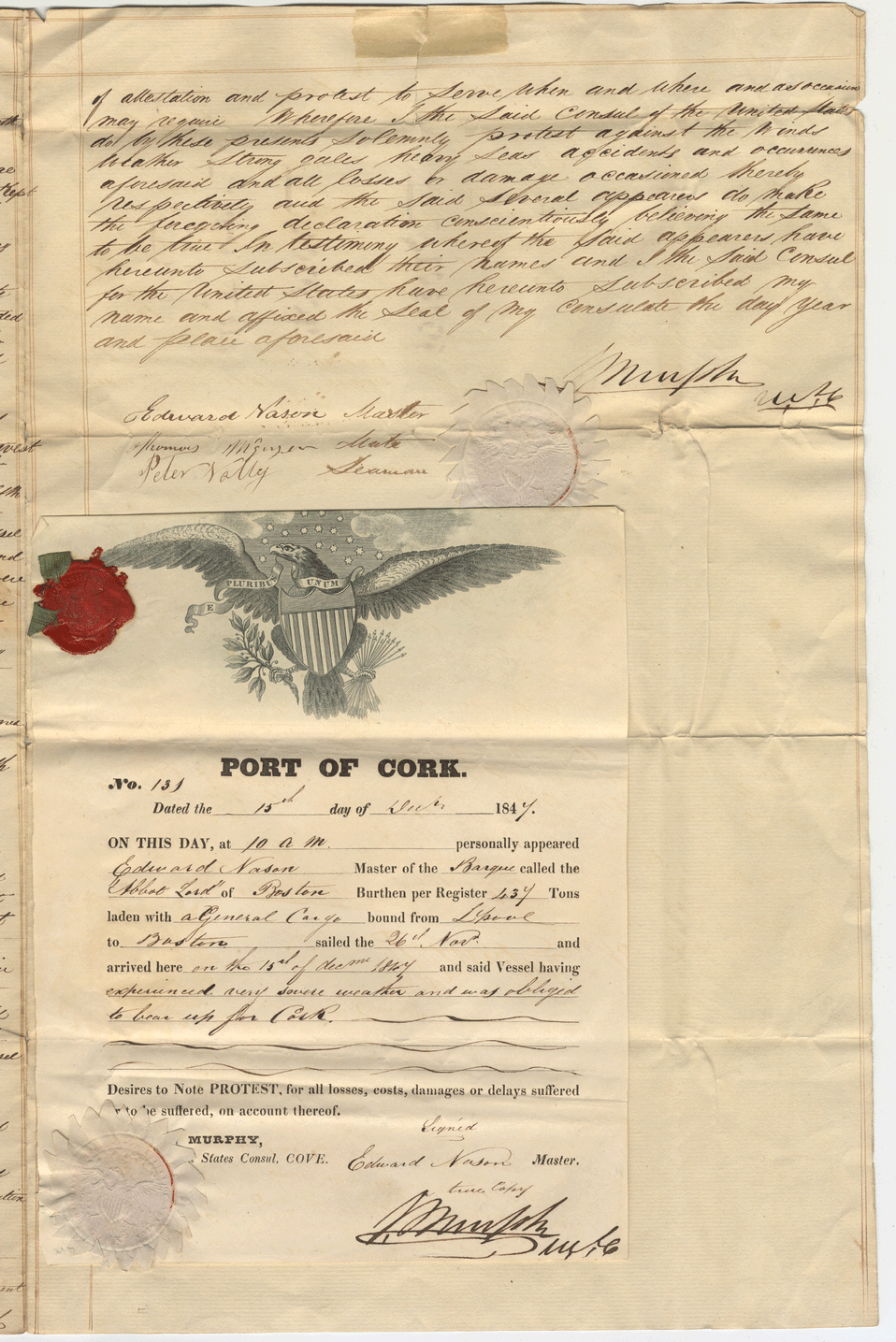
Note of Protest issued through U.S. Consul at Cork, Ireland, 15 December 1847. This document established the right to formally protest a claim within a few days if necessary.
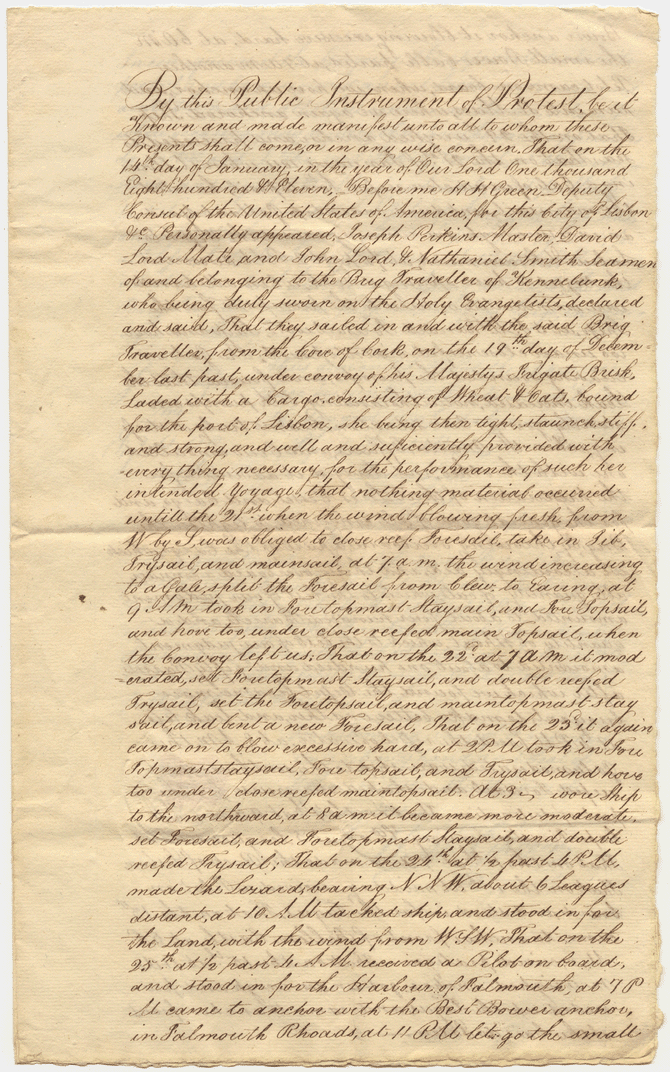
Protest executed through the U.S.Consul at Lisbon, (first page) 14 January 1811. This document was often completely handwritten, but printed forms were used also. A typical protest might be two or three pages in length, almost always beginning with the phrase, “By this public Instrument of Protest…” Common dimensions might be 12 1/2″ X 8″, with little decorated engraving. Consular seals or customs and notary stamps will be found on some copies.
Survey Certificate, 12 December 1850, on the vessel James Nesmith, signed by the Master Warden at the Port of New York. These certificates varied in content and style. Many were completely handwritten and signed by the surveyors. Some copies carried official stamps of seals.
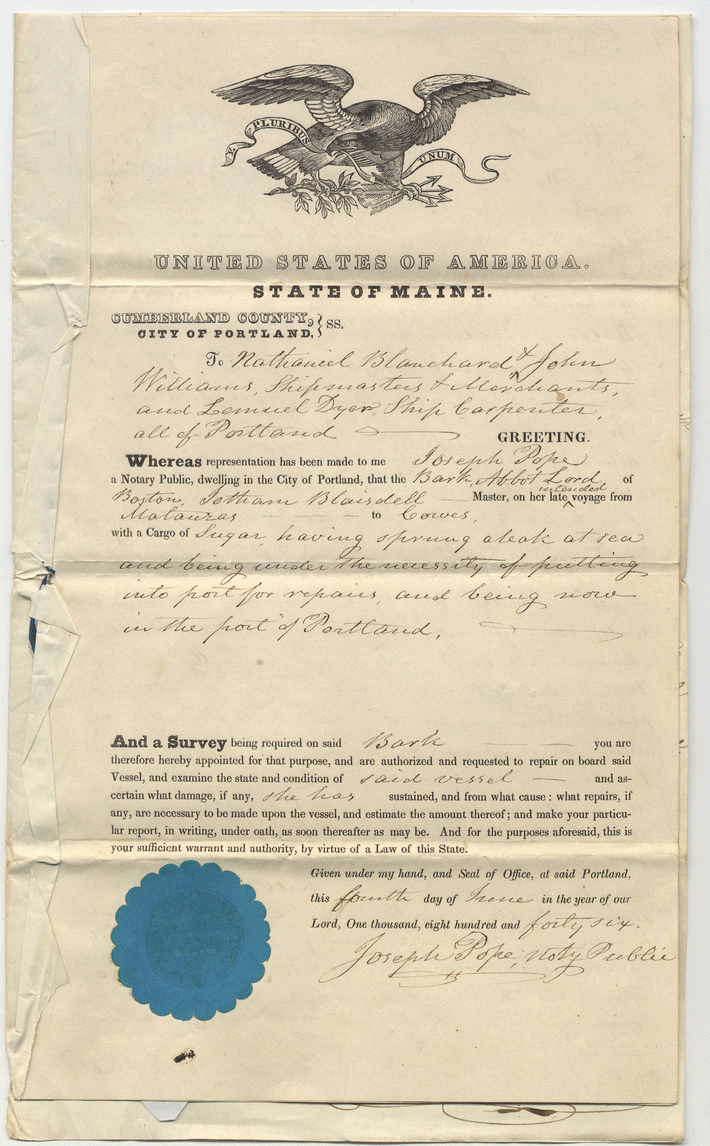
Notary document appointing two shipmasters and a ship carpenter to survey the bark Abbot Lord, “…having sprung a leak at sea and being under the necessity of putting into port for repairs…” 4 June 1846.
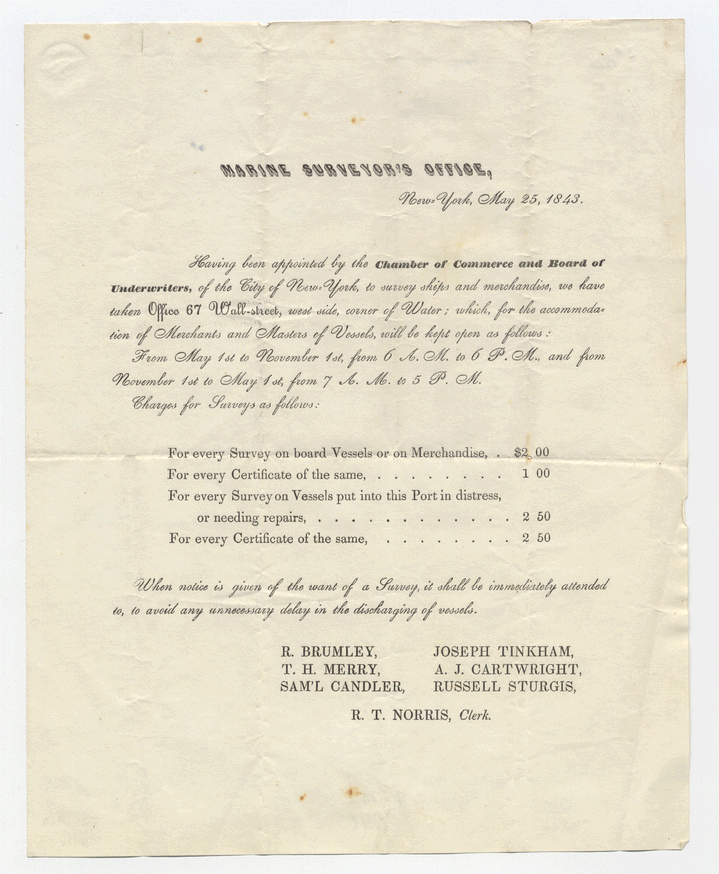
The Marine Surveyor’s notice above indicates that they were appointed by the Chamber of Commerce and Board of Underwriters of the City of New York. Their service and related charges are prominently advertised, 25 May 1843.

Bottomry Bond indicating that the master of the ship Morning Glory borrowed $9,692.76 at 25% interest in Port Townsend, Washington, 26 September 1859. Theses documents were frequently handwritten and executed before a notary, consul, or customs official. Many were more detailed than the one shown above, and would often contain several pages. There was little standardization in size or style, but 12 1/2″ x 8″ was a common measurement.
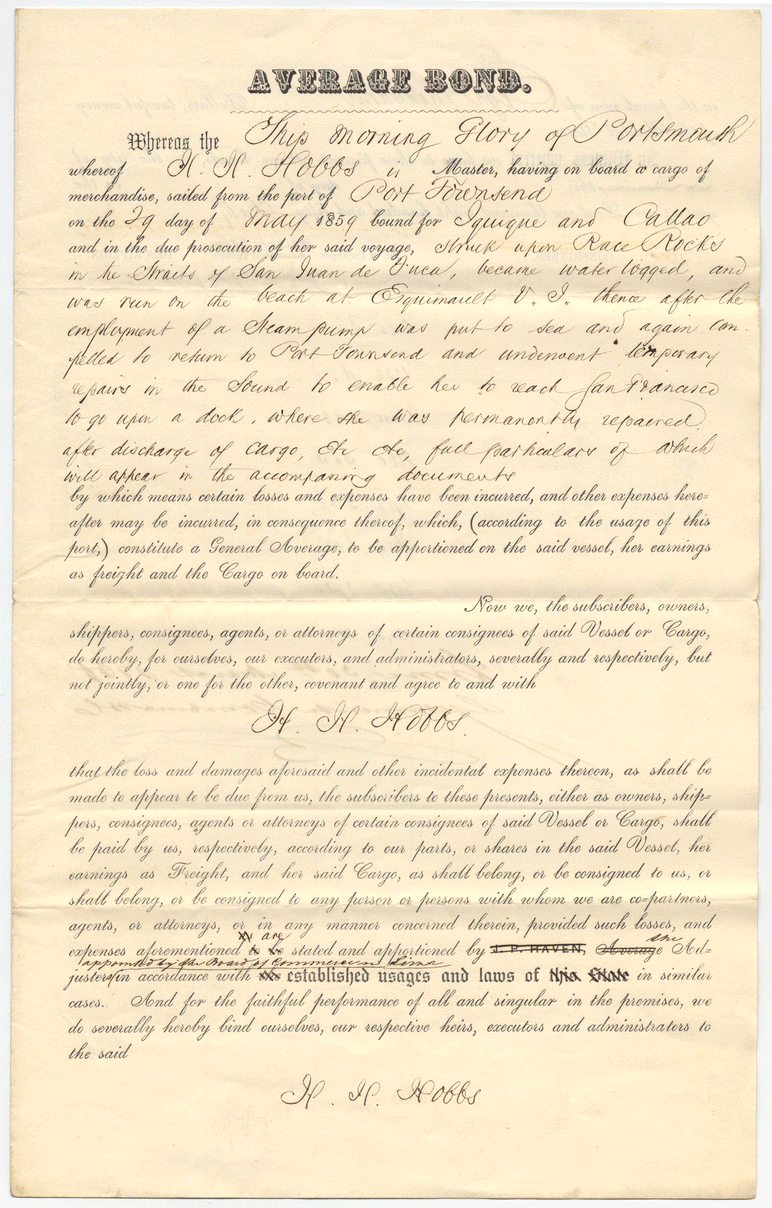
This Average Bond indicated that damage had occurred during a voyage by the Morning Glory which constituted a General Average. The master, H.H. Hobbs, is guaranteeing that everyone involved in the loss will stand by their obligations under the principle of general average, 29 May 1859.

General Average Statement (4 pages). First page describes storm damage to bark Austin during a passage from New York to Boston 24-30 October 1853. The remaining three pages contain a complete and final accounting of the average which totaled $766.70. The amount assigned to the General Average was $396.28. This document was completed by the insurance brokers in Boston and dated 25 February 1854, four months after the loss occurred. These statements often included an accounting of Particular Average; and “partial loss.” There were always handwritten business documents with no seals or stamps in evidence.
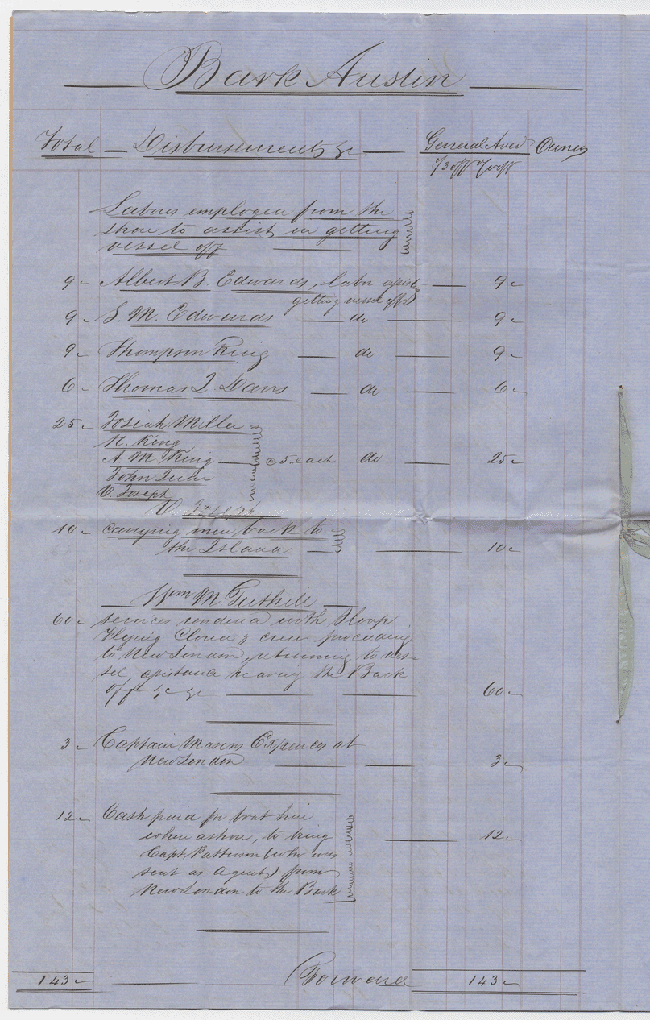
Page two of the General Average Statement listing charges to the general average and to the owners.
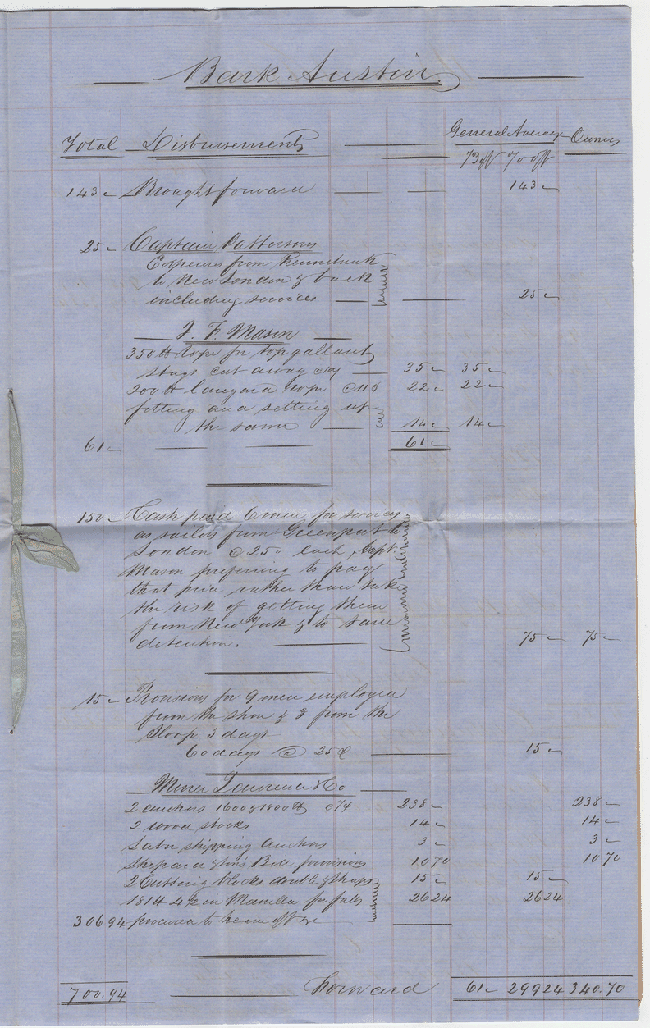
Page three of the General Average Statement listing charges to the general average and to the owners.
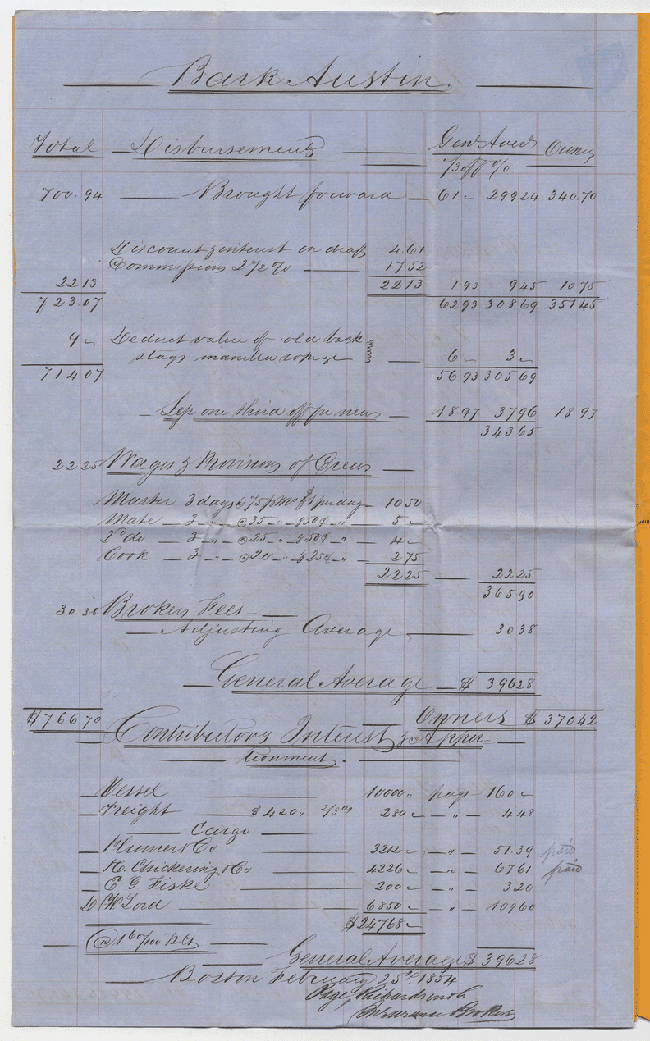
Page four of the General Average Statement showing the final accounting for the bark Austin’s damage, between the general average ($396.28) and the owners ($370.42).
